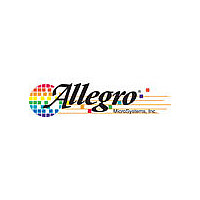SEP8WN2001 Allegro Microsystems Inc, SEP8WN2001 Datasheet - Page 10

SEP8WN2001
Manufacturer Part Number
SEP8WN2001
Description
LED MODULE, NATURAL-WHITE
Manufacturer
Allegro Microsystems Inc
Datasheet
1.SEP8WN2001.pdf
(12 pages)
Specifications of SEP8WN2001
Led Configuration
Array
Led Colour
Day White
Forward Voltage
3.1V
Display Size
13.7mm X 5.23mm
External Depth
5.23mm
External Width
13.7mm
Forward Current If Max
20mA
Lead Free Status / RoHS Status
Lead free / RoHS Compliant
SEPW Series
Because reliability can be affected adversely by improper storage
environments and handling methods, please observe the following:
Cautions for Storage
•
•
•
Cautions for Testing and Handling
Precautions During Use
•
•
•
•
•
•
•
Soldering
•
•
Ensure that storage conditions are within 5°C to 40°C and relative
humidity < 30%; avoid storage locations that experience extreme
changes in temperature or humidity.
Avoid locations where dust or harmful gases are present and
avoid direct sunlight.
Reinspect for rust on leads and solderability of products that have
been stored for a long time.
When tests are carried out during inspection testing and other
standard test periods, protect the products from power surges
from the testing device, shorts between adjacent products, and
shorts to the heatsink.
Because the light generated inside the LED must be emitted
efficiently out of the module, a resin with high light transmittance
is used. Therefore, additives that are commonly used in
semiconductor devices to improve the heat resistance or moisture
resistance (such as silica glass) cannot be added to the resin.
Consequently, the ability of the resin to withstand heat is usually
low and the following precautions must be observed.
Never apply an external force, stress, or excess vibration to resin
or terminals when at high temperature.
Take particular care about heat dissipation when designing the
application. If dissipation is not adequate, the LEDs can reach
high temperatures, with resulting color change, luminous flux
reduction, and shortening of product lifetime.
When the device is connected to an external radiator, please
coat the heatsink area with thermal conduction material such as
thermal conductive bond or thermal conductive grease.
Extra attention should be paid to the sealing resin of the product,
which is rubber-like silicon resin. The surface of sealing resin is
slightly sticky (surface tack). Therefore, touching the emitting area
or exposing it to unclean conditions may cause dust or smudges
to adhere to it and possibly penetrate the resin. This could
cause deterioration of product characteristics when contacted by
materials such as epoxy resin.
The silver plating of the leadframe may discolor if the product
comes into contact with material containing sulfides or if it is
exposed to an atmosphere containing sulfide gas.
The emitting area of the LEDs contains fine gold wires. Touching
this area without care may add excess stress on the internal gold
wires and may result in disconnection of the internal wires.
The product is in a surface mount package. The product should
not be mounted on warped direction of the PCB.
When the product is mounted by means of solder reflow and the
resin is unusually damp, solder dipping may cause interfacial
WARNING — These devices are designed to be operated at lethal voltages and energy levels. Circuit designs
that embody these components must conform with applicable safety requirements. Pre cau tions must be
taken to prevent accidental contact with power-line potentials. Do not connect ground ed test equipment.
The use of an isolation transformer is recommended during circuit development and breadboarding.
exposure to the light over an extended time period may harm eyes.
This product series emits high light output. Do NOT look directly into the light emitting area. Direct
115 Northeast Cutoff, Box 15036
Allegro MicroSystems, Inc.
Worcester, Massachusetts 01615-0036 (508) 853-5000
www.allegromicro.com
•
•
•
Electrostatic Discharge
•
Multi Chip White LED Modules
defoliation. This occurs when a drastic temperature change
causes moisture in the resin to evaporate and to swell. Therefore,
attention must be paid to the following:
After soldering, no mechanical force or excessive vibration should
be applied to the product until the product has cooled down to
normal room temperature. Quick cooling must be avoided.
When soldering the products, please be sure to minimize the
working time, within the following limits:
preheat conditions of 150°C to 180°C (at the device surface)
for 60 to 120 s, and soldering conditions less than 40 s at more
than 220°C, with a peak temperature less than 260°C, using the
following recommended profile:
guidelines in the Cautions for Storage section, above.
When handling the products, operator must be grounded.
Grounded wrist straps worn should have at least 1 MΩ of
Reflow soldering can be performed a maximum of 2 times, with
Between the first and second reflow sessions, follow the
•
•
•
•
Soldering Iron Temperature
300
260
220
180
140
100
60
20
0
Examine the moisture-resistant packing before opening. If
the indicator color (blue) of the desiccant (such as silica gel)
has disappeared, the product must be prebaked as described
below.
After the product packing is opened and staged for assembly,
soldering should be carried out as soon as practicable.
During handling, ambient conditions should be 5°C to 30°C,
with relative humidity < 70%
After 120 hours of exposure, prebake is recommended
before soldering; bake-out at 60±5°C for more than 10 hours
350±10
(°C)
50
Peak 260°C Max
60 to 120 sec
Pre-heat
100
Reflow Soldering Profile
Soldering Time (s)
150
40 sec
Max
200
3 (once only)
Time
(s)
250
300
10















